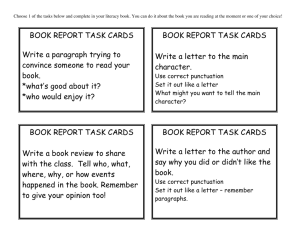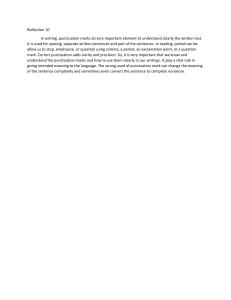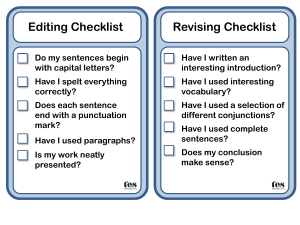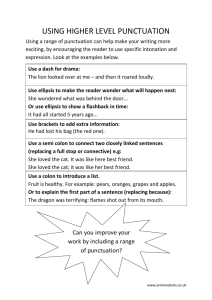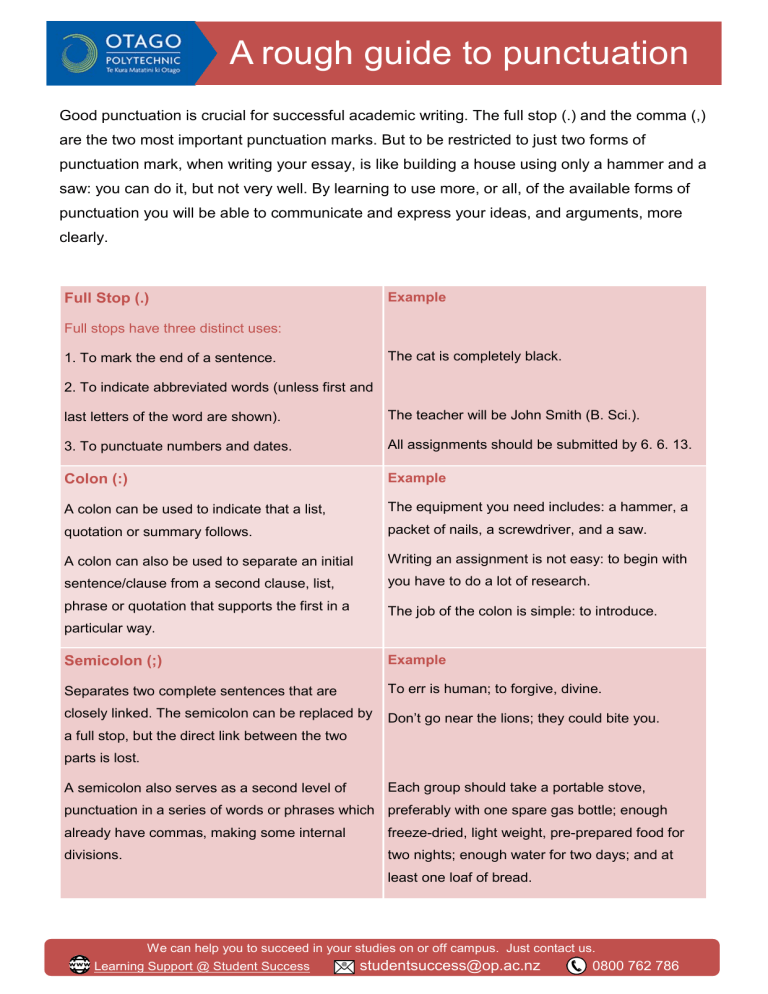
A rough guide to punctuation Good punctuation is crucial for successful academic writing. The full stop (.) and the comma (,) are the two most important punctuation marks. But to be restricted to just two forms of punctuation mark, when writing your essay, is like building a house using only a hammer and a saw: you can do it, but not very well. By learning to use more, or all, of the available forms of punctuation you will be able to communicate and express your ideas, and arguments, more clearly. Full Stop (.) Example Full stops have three distinct uses: The cat is completely black. 1. To mark the end of a sentence. 2. To indicate abbreviated words (unless first and last letters of the word are shown). The teacher will be John Smith (B. Sci.). 3. To punctuate numbers and dates. All assignments should be submitted by 6. 6. 13. Colon (:) Example A colon can be used to indicate that a list, The equipment you need includes: a hammer, a quotation or summary follows. packet of nails, a screwdriver, and a saw. A colon can also be used to separate an initial Writing an assignment is not easy: to begin with sentence/clause from a second clause, list, you have to do a lot of research. phrase or quotation that supports the first in a The job of the colon is simple: to introduce. particular way. Semicolon (;) Example Separates two complete sentences that are To err is human; to forgive, divine. closely linked. The semicolon can be replaced by Don’t go near the lions; they could bite you. a full stop, but the direct link between the two parts is lost. A semicolon also serves as a second level of Each group should take a portable stove, punctuation in a series of words or phrases which preferably with one spare gas bottle; enough already have commas, making some internal freeze-dried, light weight, pre-prepared food for divisions. two nights; enough water for two days; and at least one loaf of bread. We can help you to succeed in your studies on or off campus. Just contact us. Learning Support @ Student Success studentsuccess@op.ac.nz 0800 762 786 A rough guide to punctuation Apostrophe (‘) Two uses: Example 1. Contractions A contraction is a shortened version of a word. An don’t (do not) It’ll (It will) she’ll (she will) apostrophe is used to show that something has It’s too cold to go swimming today. been left out, and where it has been left out. I don’t think she’ll come to the party. 2. Possessives (ownership) An apostrophe is used to indicate ownership/ the dog’s tail (belonging to a single dog) possession with nouns. To show ownership by a the women’s magazines single individual, insert the apostrophe between the boys’ football boots (belonging to more than the noun and the ‘s’. To show ownership by more one boy) than one individual, use the apostrophe at the end Einstein’s theory of relativity of the word. (The dog is chasing its own tail! Possessive (Be careful: It’s is the contraction of ‘it is’.) For a more detailed explanation of apostrophes see our guide “Using apostrophes (with exercises)” pronoun its like his, hers, so no apostrophe. Question Mark (?) Example A question mark is used at the end of a sentence Have the students completed the exam? that is a question. Comma (,) Example Commas are used in longer sentences to When the Rugby World Cup was held in NZ in separate information into readable units. A single 2012, the final was a close fought contest comma ensures correct reading of a sentence between the All Blacks and the French team. which starts with a long introductory element. Pairs of commas help in the middle of a sentence In the storm, although nobody was killed, a number of people were badly injured. to set off any string of words which is either a parenthesis, or in contrast, to whatever went before. A set of commas is a means of separating items The details required are name, date of birth, in a list within a sentence. address and telephone number. Sometimes a comma is needed between the last The main divisions of the economy are two items to ensure clarity. agriculture, manufacturing, and service industries. We can help you to succeed in your studies on or off campus. Just contact us. Learning Support @ Student Success studentsuccess@op.ac.nz 0800 762 786 A rough guide to punctuation Hyphen (-) Example A hyphen links two or more words that normally Stonier’s post-industrial economy is a service would not be placed together so that they work as economy. one idea and these are called compound nouns. There are four types of information-related machines. Parentheses ( ) Example In citation systems like APA, parentheses are Larsen and Greene (2007) studied the effects of used for in-text referencing. pollution in three major cities. The effects of pollution were shown to be significant (Larsen & Green, 2007). Parentheses are brackets used to include extra or The colour of the sky (red and yellow) indicated non-essential material in sentences. Parentheses that there was bad weather on the way. should be used sparingly and always appear in pairs. Exclamation Mark (!) Example An exclamation mark is used at the end of a The police stormed in and arrested her. How sentence and indicates surprise, anger, or alarm. disgraceful! Exclamation marks should be used very sparingly and are not often used in academic writing. Ellipsis ( ... ) Example An ellipsis consists of three full stops. It indicates that material has been left out of a quotation. “But to be restricted to just two forms of When quoting, it is sometimes necessary to leave punctuation mark ... is like building a house using out words or lines for reasons of relevance or only a hammer and a saw: you can do it, but not length. very well”. Using an ellipsis makes any omissions known to your reader. Adapted from Collinson, I., Mort, P., & Downey, T-L. (2011). A rough guide to punctuation. Sydney, Australia: The University of New South Wales. To download a more detailed PDF guide to punctuation go HERE To get more help on punctuation go HERE We can help you to succeed in your studies on or off campus. Just contact us. Learning Support @ Student Success studentsuccess@op.ac.nz 0800 762 786
